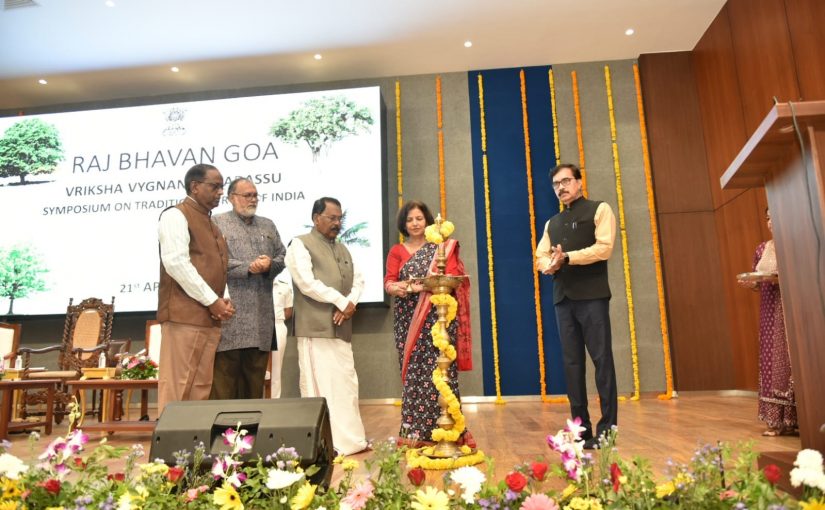AT THE SYMPOSIUM OF TRADITIONAL TREES OF INDIA: It took place at the new Durbar Hall of the Goa Raj Bhavan on April 21, 2024, the “Vriksha Vyjnanika Sadassu” program had several speakers presenting papers on the classical trees of India.
By Sathiabhama J Nair
THE “VRIKSHA Vyjnanika Sadassu” (“The Traditional Trees of India”). The essence of these eloquent words from Subhashita can be summarized as follows: Trees provide shade, shelter and sustenance, thereby epitomizing virtue and benevolence. In the rich tapestry of wisdom, they stand as providers of shade for others under their own sheltering foliage. Their fruits, in turn, serve as offerings for others. Hence, trees become our benefactors.
The symposium on traditional trees of India, held at the new Darbar Hall of the Raj Bhavan in Goa on 21 April, 2024 manifested the profound significance of trees in the ecosystem. Our ancestors recognized the paramount importance of trees in Indian heritage, embedding their knowledge and culture within the arboreal realm. It is through the branches of trees that the wisdom and culture of our forebears have been passed down to us. Indeed, the Vedas and Upanishads were inscribed within the bark of trees.
The centrality of trees in Indian culture beckons a concerted effort to enlighten future generations about their significance, as exemplified by the Vriksha Vyjnanika Sadassu. Governor of Goa, Adv PS Sreedharan Pillai’s genuine interest and knowledge about nature and trees inspired the organization of this event in the Durbar Hall of Raj Bhavan, Goa, for the enlightenment of the public.
AUSPICIOUS INAUGURAL
THE inaugural day of the Tree Scientific Symposium, graced by the presence of Swami Jagatguru Shri Shri Vidhu Shekhara Bharati Sannidhanam, amidst distinguished attendees, was truly auspicious. Each individual felt blessed by his divine touch, akin to the nurturing rain upon the soil of Goa. His presence symbolized an auspicious beginning, ushering in an era of heightened environmental consciousness.
Adv Sreedharan Pillai is an established author and has written more than 200 books. His latest work, “Heavenly Islands of Goa” was released by Damodar Mauzo, the renowned Konkani litterateur and Jnanpith Laureate. This underscores the commitment to disseminating knowledge about trees and nature. Subsequently, Swami Jagatguru delivered an insightful discourse, emphasizing the preservation of our heritage and the need for cultural education intertwined with environmental stewardship. India is widely acknowledged as the greatest nation, cherishing the significance of trees in our heritage and spanning through the annals of world history. Hence, he emphasized the imperative to learn our heritage, not merely as a religious obligation but as a cultural pursuit, intertwined with nature and sustainable living, which characterized the lives of our ancestors.
Governor Pillai articulated the necessity for us to redirect our lives towards a lifestyle centred on environmental concerns, a message he conveyed in his inaugural address. He highlighted how our allure towards Western lifestyle, driven by industrialization, marked the genesis of environmental issues, as he pointed out, “the ancient Indians were cognizant of the vitality of trees and sustainability,” a theme which echoed through our epics and literature, as he referenced in his discourse.
The Vriksha Vyjnanika Sadassu was presided by Payipra Radhakrishnan, former secretary of Kerala Sahitya Akademi. “The essence of Vedic culture has always been its profound reverence for trees and the environment,” a dialogue bridging the past with the future, as articulated in the presidential address by Payipra Radhakrishnan. Vice-President of Kendra Sahitya Akademi Dr Kumud Sharma released five books authored by Governor Pillai. They are: “Icons of My Literature,” “Kumkolim,” “Kavi Art,” “Viksit Bharat,” and “Canacona.”
Chairperson of National Biodiversity Authority C Achalender Reddy, artist KK Marar, artist Madanan, Dr A Sindhu and Payipra Radhakrishnan received copies of the books launched. Vice-Chancellor of Goa Prof Harilal B Menon, Secretary to Governor MRM Rao, R Mihir Vardhan (special officer) and TH Valsaraj (principal private secretary) addressed the gathering. Later, the symposium saw the participation of luminaries such as Dr K Murali, Payipra Radhakrishnan, Prof Jananarthanam, Prof NK Sundareshwaran, Rajendra P Kerkar, Dr P Manoharan, Dr Pradip V Sarmokadam, Dr A Sindhu, KK Marar and Dr Niya. They presented their papers on various topics.
CONSERVATION OF FORESTS
PAYIPRA Radhakrishnan talked about the conservation of the environment and forests, which are topics of global discourse today. However, the profound scientific knowledge and discoveries made by our ancestors, who lived in harmony with nature, continue to astonish us. The understanding of where and how to cultivate trees, as well as the importance of worshipping certain trees, was known to them. They identified certain “sacred groves” associated with our domestic rituals, such as Ashoka Vanam, Shiva Panchayatana Vanam, Saptarshi Vanam, Navagraha Vanam, Nandana Vanam, Nakshatravanam, and Rashivanam, as pivotal. Each paper presented by the scholars stands distinct from the others, reflecting the diversity of subjects explored. Those who contributed to this endeavour engaged in a profound exploration of varied perspectives, fostering a deeply enriching experience.
Just like Ayurveda considers the human body as composed of the five elements, Ayurvedic scholars regard plants and herbs in the same light. Like humans, trees also undergo birth, growth and healing. If we are to ensure the availability of oxygen essential for human respiration, it is imperative that we protect trees. It is said that 25 mature trees, aged at least 20 years, are required for the oxygen needs of a single person. Therefore, it is our collective responsibility to conserve trees.
NOTE: A “subhashita” (Sanskrit “subhasita” is a literary genre of Sanskrit epigrammatic poems and their message is an aphorism, maxim, advice, fact, truth, lesson or riddle. Su in Sanskrit means good; bhashita means spoken; which together literally means well spoken or eloquent saying.
(The author Sathiabhama J Nair is based in Kerala and was one of the eminent invitees for the tree symposium held at the Raj Bhavan at the initiative of Governor of Goa PS Sreedharan Pillai on April 21, 2024.)
